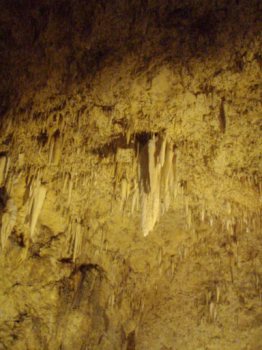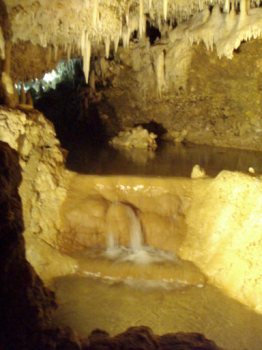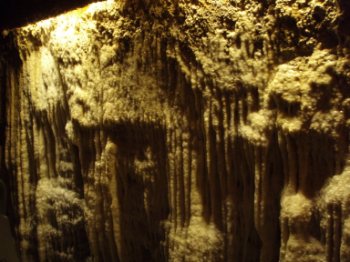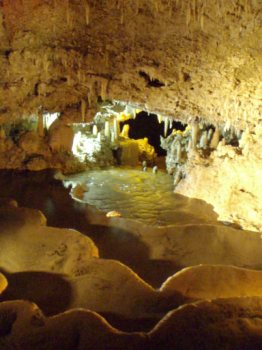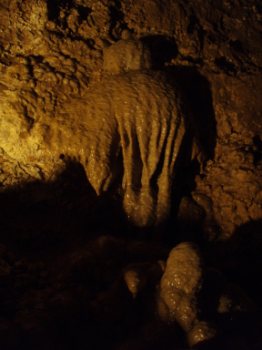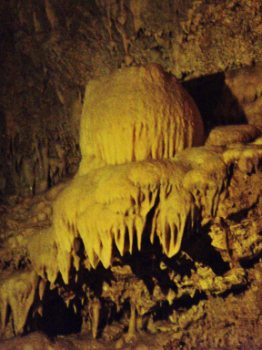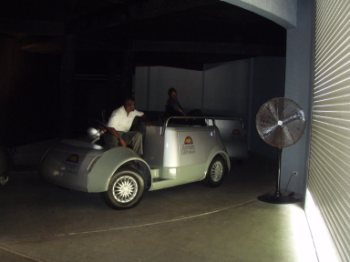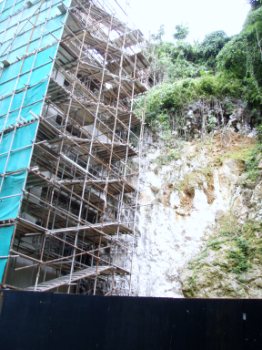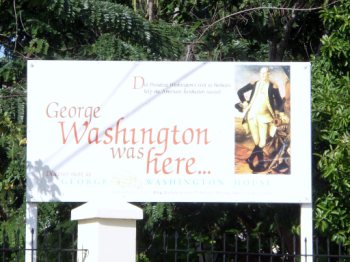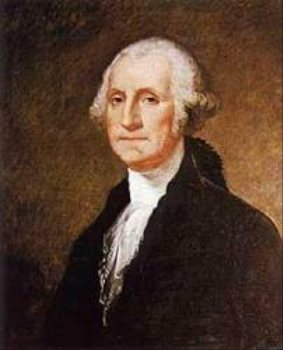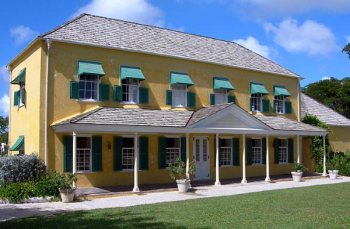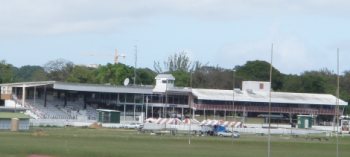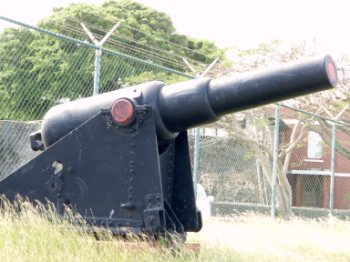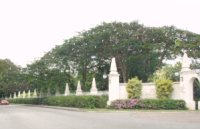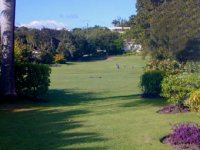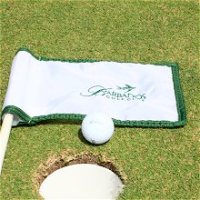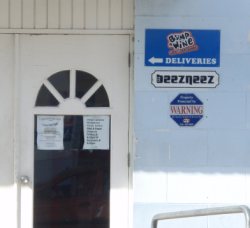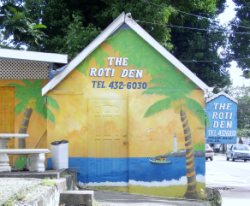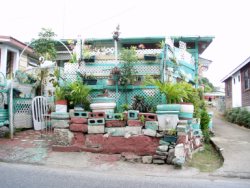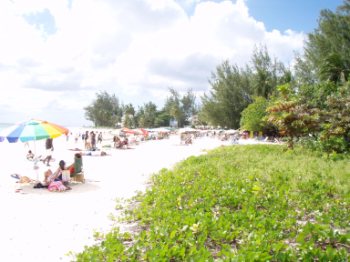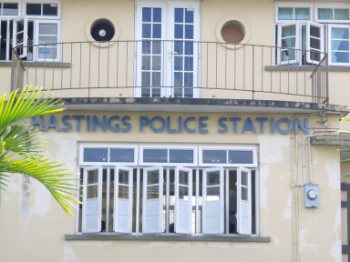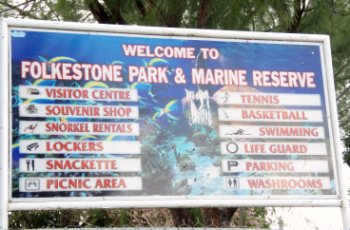Day 2 Barbados

|
Day 2 - Hire Car - Barbados
Day 2, we got up, completed day 1's blog and off we went in search of Harrison's Cave.
Harrison's Cave is a tourist attraction first mentioned in historical documents in 1795. They are named after the plantation owner whose land they were found on. Tourists can access the subterranean environment on a tramway. For almost 200 years they were forgotten. In 1976, Danish speleologist Ole Sorensen, along with Barbadian Tony Mason re-discovered them. The caves were opened as a tourist attraction in 1981. The caves allow visitors to see some of the most beautiful natural geological features of Barbados. It is now Barbados' Number One attraction.
The wall of white rock looks like shiny foam, it forms this way when water pours down sheer rock. Looking down into one of the many pools. The formation called "the Altar". The caves are naturally formed by water erosion through the limestone rock. The calcium-rich water that runs through the caves have formed the unusual stalactites and stalagmites formations. Travel through the caves is by tram, at certain points during the tour visitors are allowed to alight from the tram and get close up to the formations, flash photography is allowed.
The first photo is called "the chandelier", it looks like oozing mud, but again is rock. There is another similar looking rock (3rd photo) about seven feet above this one, it is reckoned it will take 120,000 years for them to join into one. The deepest pool at 15 feet. Water temperature is 24 degrees constant and air temperature is a constant 27 Centigrade. One main area of the caves is a huge cavern, termed "The Great Hall", measuring over 100 feet in height. After the Great Hall the tram stops at "The Village". At The Village some of the formations have joined together to form columns, this has taken many thousands of years.
The tram that took us around, the way is lit but when you pass out of an area, the guide remotely plunges it back into pitch black. I used the scaffolding (extensive regeneration of the whole of the exterior of the attraction) to show the size of the drop of a cave ceiling. This has happened in many areas all over the island, giving rise to very fertile gully's. The newly re-vamped entrance. We left the cave and had a picnic lunch sitting in the shade of some huge trees. Then off we went in search of the bird sanctuary at the bottom of the island, only to get there and find the place was boarded up. So we found:
I thought it was a little corny for the sign to say "George Washington was here". George and his scarred face. George Washington House. George Washington House. This restored Great House has quite a history. For almost 300 years it has been occupied by folk as a private home; also renters stay here for some time before moving on; it has served as commercial offices in the 1940’s, and has been a base for French prisoners. The mighty British Military Garrison used this house as part of their operations within the Garrison Historic Area. But The Bush Hill house is more noted for having George Washington as a tenant for three months in 1751. George left Virginia and boarded a vessel bound for Barbados at the tender age of 19, as a companion to his half-brother Lawrence, who suffered from tuberculosis. It was hoped the tropical climate would prove therapeutic. Unfortunately, George contracted smallpox whilst here, which left his face permanently scarred. The Barbados trip was the only overseas journey George Washington ever made. At the time they believed that the tropical climate would aid the recovery of Lawrence’s illness, sadly he died the following year. They rented the property from the commander of James Fort in the capital of Bridgetown called Captain Crofton. When this house was correctly identified as the place where George Washington stayed, the government purchased the property from the Barbados Light and Power Company and handed it over to the Bush Hill Tourism Trust Inc. Since its restoration it has been officially called the George Washington House. It serves as a museum and research centre. In 1997 William Jefferson Clinton and Hillary Clinton unveil a plaque outside this lovely house, forever linking the island of Barbados and the United States, for that once historic visit by the father of America, George Washington.
The Barbados Legion House. The Barbados Legion is made up of ex-servicemen and women. They have similar ideals as the British Legion but are by no means as well funded or resourced as their UK counterparts. With many members living on low pensions and without the support of family members, the UK Defence Advisor has asked that visiting UK forces try to assist wherever possible.
The impressive Garrison grandstand on the beautifully kept grounds. The canon next to the Legion House and across the road from the Barbados Regiment. Do they shoot you if you don't do well for your country ? The Barbados Regiment is the land force component of the Barbados Defence Force. Its main tasks are the defence of Barbados from external threats, internal security and assisting the local police in maintaining law and order. The regiment also provides Barbados' contribution to international peacekeeping and other missions. In its present form, the regiment was formed in 1979 along with the BDF, replacing the old Barbados Regiment. The Barbados Regiment is affiliated to the Royal Anglian Regiment. The Barbados Regiment was founded in 1902 as the Barbados Volunteer Force, a volunteer unit raised to provide for the local defence of the island following the withdrawal of the British garrison. Soldiers of the BVF were involved in both the First and Second World Wars as part of both the South Caribbean Force and the Caribbean Regiment. In 1948, the BVF was re-established and re-named the Barbados Regiment. The regiment received its first stand of colours in 1953. These colours were later changed after the country gained Independence. Between 1959 and 1962, Barbados was part of the Federation of the West Indies, and thus contributed to the 3rd Battalion, West India Regiment. On the break-up of the Federation, Barbados regained its independence and saw the Barbados Regiment returned to service. Although the regiment's primary role is to defend Barbados, it also provides the country's commitment to UN peacekeeping forces, predominantly in the Caribbean region. The regiment also participated, along with the Jamaica Regiment and the Rifle Company, Antigua and Barbuda Defence Force, in the United States led invasion of Grenada in 1983. The Barbados Regiment is stationed as part of the BDF headquarters at The Garrison. The regiment today is divided into regular and reserve forces, essentially making up two 'battalions'.
On the way back to Beez Neez we saw the Barbados Golf Club
Some pictures that amused us were, Carlisle Beach, with Bridgetown behind it, this is the other 'clearing-in' port we could have used. A BeezNeez poster, haven't got to the bottom of that, we do know it's a lager in Australia, but not sure what it means here. The Roti Den, roadside cafe Barbados style. There is a house in there in the last picture.
Worthing Beach, Hastings Police Station and Folkestone Beach sign. So many places here are named after good old Blightey.
ALL IN ALL a busy and enjoyable day.
|
